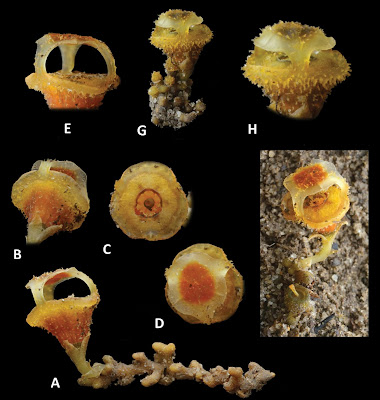 |
| Scinax pixinguinha Lacerda, Ferreira, Araujo-Vieira, Zocca & Lourenço, 2021 DOI: 10.1643/h2020091 |
Abstract
The Scinax catharinae clade comprises the S. perpusillus and S. catharinae groups. The S. catharinae group has 38 species, mostly from Brazil's Atlantic Forest. We describe a new species of S. catharinae group based on external morphology, color pattern, and bioacoustics. The new species calls from herbaceous vegetation of slow-flowing streams from Santa Teresa, State of Espírito Santo, southeastern Brazil. The new species is distinguished from species of the S. catharinae group by the following combination of characters: male SVL 24.8–28.3 mm and female SVL 31.2–38.6 mm; males with hypertrophied forearms and inguinal glands; interocular region with a dark blotch not exceeding beyond the anterior margin of tympanic level; black blotches on a whitish-green background on the inguinal region and hidden surfaces of legs; call type A of 0.301–0.883 s, and 12–30 notes emitted at a rate of 31.4–42.0 notes/s. We also provide remarks on its natural history and conservation status.
 |
| Scinax pixinguinha (MNRJ 93666; SVL 26.7 mm) the bright yellow night coloration during fieldwork |
Scinax pixinguinha, new species
Etymology.— Alfredo da Rocha Vianna Filho (1897–1973),
popularly known as Pixinguinha, was a Brazilian musician
and the most famous Choro player. Choro or Chorinho is a
Brazilian genre of popular music originated in the 19th
century. In Portuguese Choro or Chorinho means ‘‘cry’’ or
‘‘little cry,’’ respectively. Ironically, Chorinho is a contagious
music commonly played during joyous moments in Brazil.
Brazilians usually say Pixinguinha was a kind of magician
who learned how to convert tears of Choro (cry) into tears of
happiness. Because 72% of the Atlantic Forest original cover
has been deforested, discoveries of new species also has the
power to momentarily change part of our conservationist
sadness into happiness and motivation. Thus, the specific
epithet of S. pixinguinha is a noun in apposition in honor of
the talented Brazilian musician—Pixinguinha.
João Victor Andrade Lacerda, Rodrigo B. Ferreira, Katyuscia Araujo-Vieira, Cássio Zocca and Ana Carolina C. Lourenço. 2021. A New Species of Scinax Wagler (Amphibia, Anura, Hylidae) from the Atlantic Forest, Southeastern Brazil. Ichthyology & Herpetology. 109(2); 522-536. DOI: 10.1643/h2020091


















































